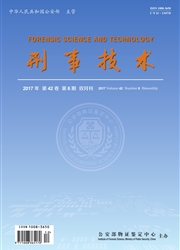

 中文摘要:
中文摘要:
目的研究福州地区山地土壤中植物孢粉组合的特异性。方法用乙酸乙酯和稀盐酸溶液浸泡盖山和屏山土壤,经震荡和离心分离收集土壤中的植物孢粉,用扫描电镜观察植物孢粉的显微形貌,根据植物孢粉的形状、粒径大小、表面纹饰和外壁图案鉴别不同种类的植物孢粉,且根据土壤中的植物孢粉组合特征来区分不同的山地土壤。结果盖山和屏山土壤中的植物孢粉组合不同。对于同一山体,不同位置(山脚、山腰和山顶)、不同深度(表层、表层以下2 cm和表层以下4 cm)和不同季节(春季、夏季和冬季)的盖山和屏山土壤中所含的植物孢粉组合均不同。结论不同位置、不同深度、不同季节的盖山和屏山土壤中所含植物孢粉组合均具有明显的特异性,根据土壤中的植物孢粉组合特征可以区分不同山体位置、不同土层深度和不同季节的山地土壤。
 英文摘要:
英文摘要:
Objective To study the specificity of plant pollen complex in mountainous soils in Fuzhou. Methods Soil samples were collected from the different locations and depths of Mount Ping and Mount Gai of Fuzhou City in different seasons. To separate the pollen from the soil, the samples were soaked in ethyl acetate and 30% hydrochloric acid solution respectively, and plant pollens in soils were collected after being stirred and centrifugation. Microstructures of pollen were analyzed by the scanning electron microscope (SEM). Different types of plant pollen can be identified according to their external features including shape, size, surface pattern and aperture of pollen. Different plants grew at different places and their pollen grains were dispersed with wind or animals. Some larger pollen grains, such as corn pollen, cannot travel far and can only drift with the wind for about one-half mile. The different mountainous soils can be distinguished according to pollen complex contained in them, Results Mount Gai soil samples and Mount Ping soil samples contained different pollen, and different pollen complexes were found in mountainous soils collected in different mountain locations (mountain's foothills, mountainside and mountaintop), depths (surface, 2 cm beneath surface and 4 cm beneath surface), and different seasons (spring, summer and winter). Conclusions Pollen complexes contained in the soils of Mount Gai and Mount Ping from different locations, depths, and different seasons, exhibited obvious specificity. Therefore, mountainous soils from different mountain locations, depths and seasons can be distinguished according to the specificity of pollen complex contained in them.
 同期刊论文项目
同期刊论文项目
 同项目期刊论文
同项目期刊论文
 期刊信息
期刊信息
